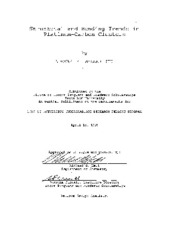| dc.creator | Miller, Thomas F. | |
| dc.date.accessioned | 2013-02-22T20:41:19Z | |
| dc.date.available | 2013-02-22T20:41:19Z | |
| dc.date.created | 1999 | |
| dc.date.issued | 2013-02-22 | |
| dc.identifier.uri | https://hdl.handle.net/1969.1/ETD-TAMU-1999-Fellows-Thesis-M558 | |
| dc.description | Due to the character of the original source materials and the nature of batch digitization, quality control issues may be present in this document. Please report any quality issues you encounter to digital@library.tamu.edu, referencing the URI of the item. | en |
| dc.description | Includes bibliographical references (leaves 41-44). | en |
| dc.description.abstract | Density functional calculations with the B3-LYP functional were used to optimize the platinum-carbon cationic clusters, PtCx+, 1=x=16, in both the doublet and quartet states of the linear, fan, open-ring, closed ring, and one-carbon ring geometries. Trends in stability, Pt+-Cx binding energy, doublet-quartet excitation energy, and Pt-C bond lengths were investigated. Explanations for these patterns are provided in terms of orbital interactions and changes imposed on the carbon-chain by the metal atom. In accord with the previously studied palladium-carbon cations, the PtCx+ clusters favored a linear geometry for 3=x=9. For larger clusters, the open-ring (Pt inserted in Cx ring) and closed ring (Pt bound to two atoms of closed Cx ring) families exhibit the lowest energy structures. The stability and the nature of the Pt-C bonding in both the closed ring and one-carbon ring (Pt bound to one atom of closed Cx ring) PtCx+ structures depend greatly on the aromaticity of the corresponding Cx ring. However, unlike their palladium counterparts, the closed-ring platinum clusters were found invariably to be more stable than the respective one-carbon species. The stability of forming two Pt-C s bonds is due to relatively lower energy sd hybrid orbitals from the platinum cation. | en |
| dc.format.medium | electronic | en |
| dc.format.mimetype | application/pdf | |
| dc.language.iso | en_US | |
| dc.publisher | Texas A&M University | |
| dc.rights | This thesis was part of a retrospective digitization project authorized by the Texas A&M University Libraries in 2008. Copyright remains vested with the author(s). It is the user's responsibility to secure permission from the copyright holder(s) for re-use of the work beyond the provision of Fair Use. | en |
| dc.subject | chemistry. | en |
| dc.subject | Major chemistry. | en |
| dc.title | Structural and bonding trends in platinum-carbon clusters | en |
| thesis.degree.department | chemistry | en |
| thesis.degree.discipline | chemistry | en |
| thesis.degree.name | Fellows Thesis | en |
| thesis.degree.level | Undergraduate | en |
| dc.type.genre | thesis | en |
| dc.type.material | text | en |
| dc.format.digitalOrigin | reformatted digital | en |


